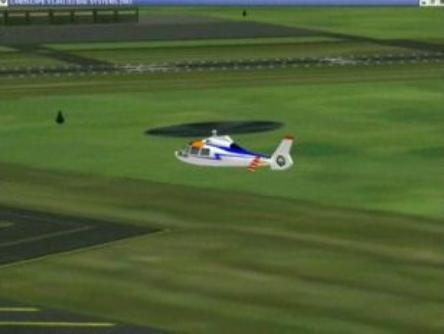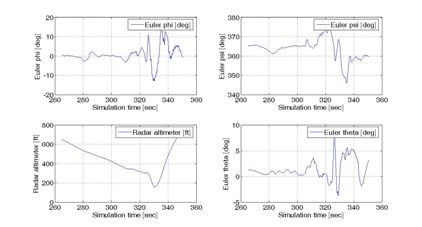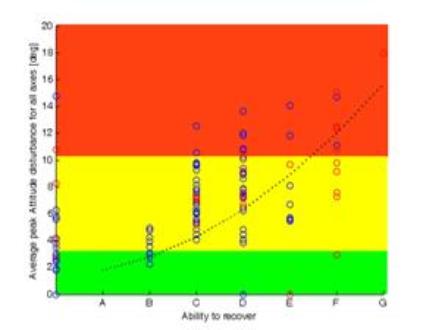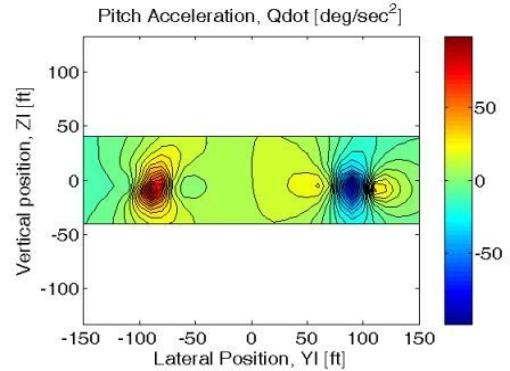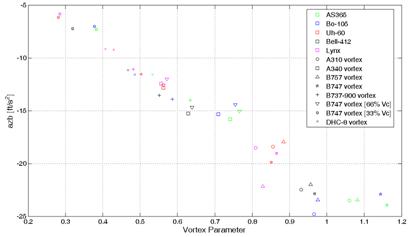OPTIMAL - Research Highlights
The aims & objectives of the University of Liverpool's contribution to OPTIMAL were focussed on developing further understanding of the flight dynamics of rotorcraft in wake vortex encounters, especially in the context of the new OPTIMAL rotorcraft procedures. This was to be acheived through the development severity metrics and criteria through piloted simulations. Also tools were developed to predict the likely severity of an encounter and to perform parametric analyses of Wake Vortex Encounters (WVE). The results from this analysis have been combined with a study of wake vortex decay and transport behaviour to make recommendations for the safety case for future Rotorcraft Simultaneous Non-Interfering operations.
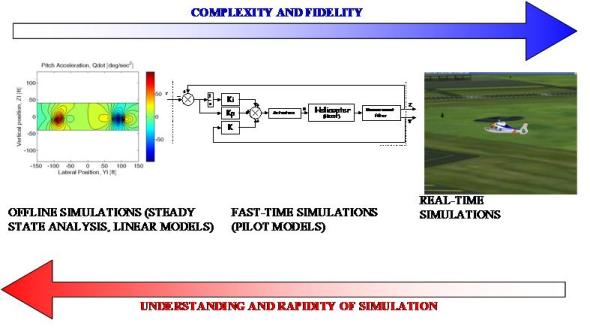 The research has used a number of modelling and simulation techniques to help answer the challlenges posed by the OPTIMAL objectives. The philoshpohy has been to use a number of complimentary analyses that cover the spectrum from the piloted simulations (complex but perhaps more difficult to interpret) to the analytical approximations that are fast to compute and can cover many scenarios but sacrifice fidelity to acheive this. The figure to the right illustrates this concept and shows the tradeoffs and agains that each approach offers.
The research has used a number of modelling and simulation techniques to help answer the challlenges posed by the OPTIMAL objectives. The philoshpohy has been to use a number of complimentary analyses that cover the spectrum from the piloted simulations (complex but perhaps more difficult to interpret) to the analytical approximations that are fast to compute and can cover many scenarios but sacrifice fidelity to acheive this. The figure to the right illustrates this concept and shows the tradeoffs and agains that each approach offers.
The following subheading provide an overview of the different research areas this work has covered and shows a number of results and typical data acquired.
PILOTED SIMULATION:
|
A 'snapshot' of The FLIGHTLAB Dauphin Simulation on Final Approach Piloted wake vortex encounter simulation trials have been conducted with AS356N Dauphin and UH-60 ‘Blackhawk’-like rotorcraft simulation models (and some limited experiments with other types). The simulation trials featured many approaches flown with varying glideslopes, wake strengths and heights, visual conditions and 3 test pilots. The pilots used a 'Vortex Wake Severity Rating scale' (VSR) and the subjective pilot ratings of severity were compared with aircraft attitude and height upset measurements from the encounters.
|
|
Time history of the roll, pitch, yaw and height perturbations of rotorcraft encountering a Wake Vortex
|
Offline Rotorcraft Wake Vortex Encounter analysis tools:
|
Instantaneous pitch acceleration induced on a Dauphin helicopter if placed in different locations of a Boeing 747 wake vortex pair |
|
An offline wake vortex encounter induced acceleration ‘contour’ analysis was developed that could compare various encounter geometries (e.g. parallel or crossing intercept etc), different rotorcraft models and wake vortices. Also, an analytical WVE model has been developed that can rapidly calculate the initial disturbance that a particular vortex has on a particular rotorcraft configuration. This form of model allows for efficient parametric analyses as based on linear derivative models that use fundamental parameters. The research also attempted to correlate the output of this model to a ‘Vortex Parameter’ that represented the encounter scenario and which could be used as predictive metric of the likely severity. Example results from the analytical model for vertical accelerations induced for a number of rotorcraft / wake vortex combinations |
Wake Vortex Behaviour and its potential impact on SNI operations:
As well as investigating the flight dynamic response of a rotorcraft to a wake vortex through simulations, the hazard of a wake vortex encounter has to be considered within an overall framework of ‘risk’ i.e. how likely is the occurrence of a wake vortex encounter of a given severity. Primarily, this issue demands the ability to predict or measure the transport and decay of wake vortices i.e. where are they and how strong are they. What makes this problem particularly complex is that, for each airport, a proposal for SNI operations is going to have its own unique characteristics. There will be a different set of prevailing wind trends, atmospheric conditions, runway and rotorcraft FATO locations and flightpath positions, all of which change the SNI risk outlook.
Comparing against 250m ICAO annex 14 criteria, results in published sources have shown wakes measured travelling laterally up to 429m (1407ft) [1]. The need to consider wake vortex evolution requires understanding of the wake transport and decay, the effect of atmospheric conditions and winds whilst SNI operations allow for almost infinite combinations of wake generater aircraft and encountering rotorcraft as they are completely independent of each other.
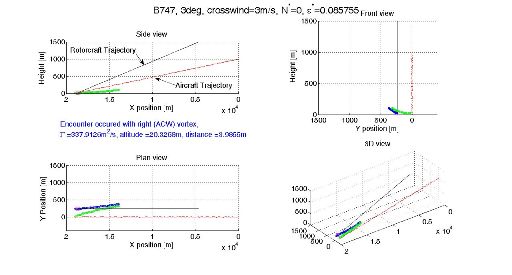
Demonstration of the UoL P2P model showing an encounter of a wake vortex generated by an aircraft encountering with the flightpath of a parallel helicopter flightpath.
As well as researching the published measured data, the research project has developed a version of the P2P ‘Probabilistic 2 Phase’ model [2]. This phenomenological model can model wake vortex decay and transport based on combination of empirical and physical relationships using inputs such as the background turbulence level, sratification, winds and the initial vortex height and strength. This has helped to guide the recommendations for SNI operations and to cast the risk of the likelihood of the occurence of encounter against the severity of an encounter.
1. Burnham, D. C. and Hallock, J. N., "Wind Effects on the Lateral Motion of Wake Vortices," Vol. DOT/FAA/AAR-99/-88, US Department of Transportation/ Federal Aviation Administration, Office of Aviation Research, Washington, DC, 1999.
2. Holzapfel, F., "Probabilistic Two-Phase Wake Vortex Decay and Transport Model," Journal of Aircraft, Vol. 40, No. 2, 2003, pp. 323-331.
